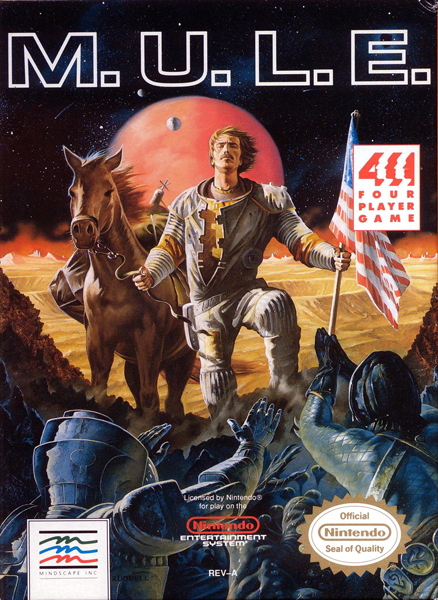
M.U.L.E.
System: NES
Release Date: September 1990
Developer: Eastridge Technology
Publisher: Mindscape
Genre: Simulation
The name of the game is profit in M.U.L.E.! Other planets are ripe for exploration and resource exploitation, so who better than you to rip up the planet’s surface for financial gain? Choose one of three modes, each with slightly different rules, but the same goal, net worth. Which of eight alien races will you choose?
The summary report shows everyone’s net worth in categories of money, land, and goods. These will increase during the game, unless you’re terrible. The number of months until pickup tells you how many turns the game will take. Your first task is to select a plot of land. A square starts in the upper left corner and moves rapidly to the right and down the rows. Be the first to press the A Button when the plot you want is highlighted and it’s yours! Unless the AI wants the same square and is worse off financially than you, then they win all ties. Occasionally, you are offered a chance to bid on an extra plot of land. There’s a minimum opening bid that must be met in order for the land to sell.
Once you’ve got your land, you need to set it to produce. In town, you can purchase a M.U.L.E. from the corral and then outfit it to produce food, energy, or smithore. Then you leave town and take it to your plot. Now you can hunt for wampus, or head back to the pub to win some money from gambling. Placing like resource plots next to each other gives you a bonus to production through economies of scale. After the turn is over, you see how much production each plot of land earned. Then it’s off to the auctions!
You’re shown how much of each resource you came into the round with, then how much you used, how much spoiled, how much you produced, and whether you have a surplus or shortage. Each player then sets themselves on either the buying or selling side. The auction plays out with sellers walking down to the price they’re willing to sell for and buyers walking up the price they’re willing to buy at. It’s supply and demand, and there are consequences if you don’t have enough resources, but the AI seemed to take the consequences and not really be harmed most of the time. If they aren’t interested in buying or selling, you can work with the shop if they have any units in inventory.
There are a number of random events that can happen between turns. These tend to reduce production of a resource, or steal them from you outright! If you’re in first place, you never get good events and if you’re in last, you never get bad events (except for pirates). The Standard and Tournament games add new rules, such as having to reach a colony wide net worth at the end of the game. Or the introduction of Crystite. I didn’t find these to be much fun against the computer, as they seem to be set up for human interaction. It’s hard to collude or make a plan for survival with the AI.
Graphics: 1.0
The graphics look like they’re from an early 80s computer game (because they are)!
Sound: 1.0
There is sparse music and less than good sound effects.
Gameplay: 1.5
Broken supply and demand because there are no consequences for the AI. As an economist, it makes me sad.
Difficulty: 1.5
I won both the games I played, though my colony was too stupid to do well enough to succeed in the Standard game.
Fun Factor: 1.5
It’s too slow, too boring, and doesn’t do the economics particularly well.
Overall Rating: 1.3
M.U.L.E. earns a D+. This is disappointing, I thought this game would be right up my alley, but the supply and demand simulation is broken. If you need something to scratch an economic simulation itch, this might leave you wanting for more.
